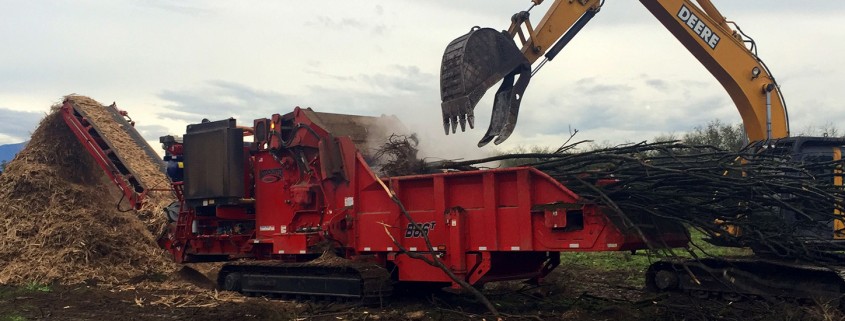Hazelnut Tree Grinding
Hazelnut Tree Grinding
With orchards of hazelnut trees being pulled out due to the Eastern Filbert Blight, Denbow provided hazelnut tree grinding services onsite, to help remove the fungus trees.
What is Eastern Filbert Blight?
Eastern Filbert Blight is caused by the fungus Anisogramma anomola and is indigenous to the Northeast United States. It is an unimportant parasite causing a small canker on the native American Hazelnut, Corylus americana. However, on the introduced and commercially important European Hazelnut, Corylus avellana, it causes a lethal disease. Early attempts to establish hazelnut orchards in the Northeast U.S. failed because the disease could not be controlled. Hazelnut production in the Pacific Northwest, which was free of the disease, flourished, but in 1973, the fungus was discovered there as well.
Symptoms
The first symptoms to appear on infected trees are elliptical black stromata. They are formed in longitudinal rows on infected branches, and appear only after extended cold periods, usually between Symptoms and Signs Anisogramma anomola May and August. The first stromata to appear erupt from branches 12-18 months after the initial infection. The infected area is known as a canker, and these cankers are perennial, adding both additional rows and more stromata to existing rows each year. On European Hazelnut, these cankers can expand from a few centimeters up to 1 meter annually; on American Hazelnut they increase by only 1-10 centimeters in the same amount of time. Infected branches become girdled. Leaves on these branches die, remain attached, and flag the presence of the disease during the summer months. The tree declines, with many leafless, dead, and dying branches visible in the canopy. If no action is taken, in 5-12 years time the tree will be dead.
Management Strategies
Scouting
Scout trees in the winter for cankers, and in the summer between July and August for flagging branches. Check these for cankers as well.
Pruning
Infected branches should be pruned .6 to .9 meters below the edge of a canker, as the fungus grows ahead of the area in which it produces reproductive structures. The cut branches should be burned or chipped, because the fungus can continue to sporulate in the branch as long as it has moisture.
Full Removal
Sometimes the tree just cannot be saved. This is where Denbow’s onsite grinding services came in to help out. We dispatched or mobile grinder to site to help chip up the diseased hazelnut trees. We feel for the farmer and the loss that this infection has had on their farms. We hopefully helped save other hazelnut trees in the area.
Here is a video from the project.
We would be happy to provide you with a free quote to take care of grinding the tree piles, with an option to haul the ground material out.





Leave a Reply
Want to join the discussion?Feel free to contribute!